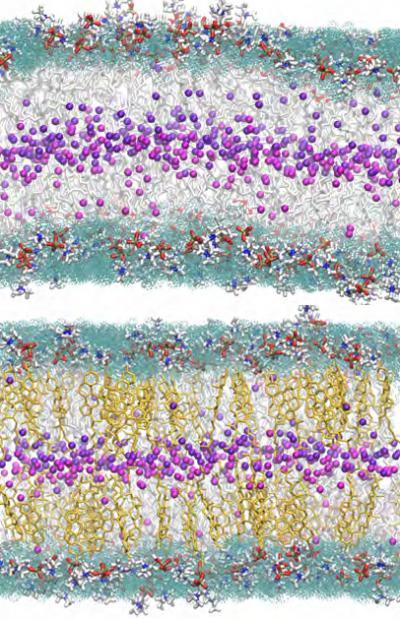Optical microscopes offer limited resolution, while the more powerful electron microscopes require freezing samples before they can be magnified. But by using neutron diffraction, which does not require frozen subjects, the team not only observed the membrane more closely and in motion, but they also gained insight into the long-known phenomenon of the membrane growing thicker and stiffer in the presence of cholesterol.
These lipid chains form a two-layer skin with the "heads" of the lipids facing outward toward the cell's exterior and interior and the "tails" intermingling on the inside of the cellular membrane. Cholesterol is known to be important for managing disorder in membranes. The team saw for the first time that when cholesterol is present, these tails line up in a tight formation, looking like a narrow stripe from which the lipid chains stretch outward—and producing the order that had been previously anticipated, but never shown directly. But without cholesterol, the tails go a bit wild, flapping around energetically and in some cases even pushing up toward their chains' heads.
Mihailescu says the findings hint that cholesterol may have profound consequences for the membrane's gatekeeper proteins, which are very sensitive to their environment. "The membrane and its proteins interact constantly, so we're curious to learn more," she says. "With this unique magnification technique, we can explore the cell membrane more effectively than ever possible, and we are now establishing a research program with the University of Maryland to do so in greater detail."

The purple "tails" of the lipid molecules that form the cell membrane are far less orderly in the absence of cholesterol than when cholesterol is present, a finding made possible by magnifying the membrane with neutron diffraction. This is an animation of the data showing the movement of the membrane with cholesterol present.
(Photo Credit: NIST)

The purple "tails" of the lipid molecules that form the cell membrane are far less orderly in the absence of cholesterol (top image) than when cholesterol is present (bottom), a finding made possible by magnifying the membrane with neutron diffraction.
(Photo Credit: NIST)
Source: National Institute of Standards and Technology (NIST)